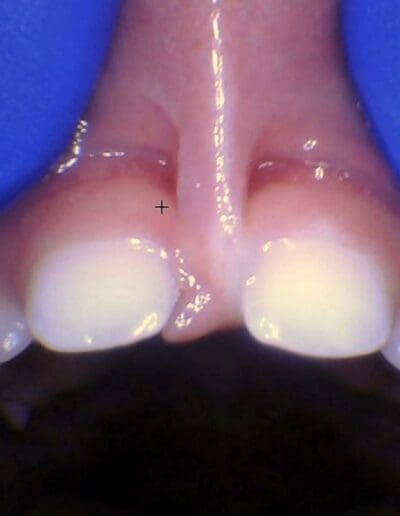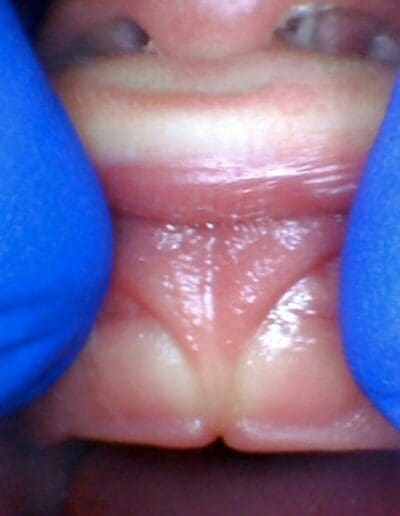If you suspect your baby has tongue-tie (ankyloglossia), this guide is full of health information that will help identify the tongue tie and find a potential solution -so your baby can get the nourishment needed to grow and flourish!
What is a Tongue Tie (Ankyloglossia)?
In tongue tied babies, this little piece of tissue (the lingual frenulum) tethers their tongue much closer to base of their mouth. As you can imagine, when this tissue is attached closer to the tip of the tongue, it’s makes it difficult for that tongue to move up and down as well as in and out of the mouth, which makes it difficult to latch onto your breast or a bottle.
A tongue tie at the tip of the tongue will dramatically reduce the range of motion and functionality of a babies tongue for breastfeeding and can sometimes create a heart shape in the tip of the tongue. The good news is that it’s possible to identify and correct a tongue-tie so your baby (and you!) can return to healthy living.
My Story With a Tongue Tied Baby
My passion for helping Moms and babies stems from a long and confusing journey as a new mother. For many babies, a tongue tie is quickly recognized by a medical professional after birth. I wasn’t so lucky. Lily, my oldest of 3 girls, struggled to feed for months. It seemed like she fed around the clock and was always irritable. She would make a clicking sound during feeding and was extra squirmy which left us both tired and frustrated.
I went to well baby clinics for weighted feeds, asked multiple lactation consultants and got second opinions from pediatricians… Still no answers. I had all but given up on breastfeeding at 6-months as the pain of cracked and bleeding nipples were too much to bare.
When I noticed a blister had formed on her lip, I decided to ask around at dental school. Here I was, completely surrounded by medical professionals (that specialize in the human mouth, no less), and yet nobody, including myself, could see the problem was my baby’s tongue-tie.
As Moms, we do everything we can to prepare for labor and childbirth. We know the benefits of breastfeeding and expect we’ll be able to feed our newborn baby some how. Though it can be natural for babies to lose up to 10 percent of their birth weight, it’s scary when we can’t transfer enough milk in a feeding to help them gain the weight back.. Like, it’s our one job. Everything in our nature needs to provide for this babe but every ounce lost puts the weight of the world on our shoulders.
Breastfeeding can be incredibly rewarding or frustrating -some days it both! Here’s a quote that gave me some peace:
“Although the ability to breastfeed is natural, it’s not natural like breathing, it’s natural like walking, which needs to be learned and learning is much easier with support.”
– Unknown CLC
Now, as a Dentist, Certified Lactation Counselor® (CLC®), and a mother who gave birth to 3 tongue tied babies, I love helping other Mom’s and babies struggling with tongue and lip ties. This page includes everything I wish I had known years ago as the new mother of a tongue-tied baby. ❤️
Dr. Brielle Renz
Dentist & Certified Lactation Counselor (CLC)
How Do I Know If My Baby Has A Tongue Tie?
Symptoms of a tongue tie may be recognized in the baby, the mother, or both baby and mother. Many tongue-ties are first recognized when the baby cries or when a mom notices that feeding the child has become difficult. Tongue ties are recognized by mothers, nurses, lactation consultants, doulas, and doctors; though they can go unnoticed until problems crop up.
Mom’s Symptoms
Nipple pain
Lipstick shaped nipple
Baby’s Symptoms
Difficult or shallow latch
Does a Tongue Tie Need To be Treated?
Tongue function and range of motion
Symptoms experienced by both Mom and baby
Appearance of the tongue
Many Tongue Ties Go Unnoticed by the Untrained Eye
Orofacial development
Speech and behavioral patterns
High and narrow palate development
Crowding of the teeth
Airway obstruction leading to sleep apnea and snoring
Later in life, a tongue tie may affect how your child eats, breathes, sleeps, swallows and speaks -as was the case in the viral video:
How Should We Treat a Tongue Tie (Scalpel, Scissors, or Laser)?
The procedure to treat a baby’s ties may be referred to as a frenectomy, frenulectomy, or frenulotomy depending on the nature of the tie. There are 2 common ways to treat a tongue tied baby:
Scissors/scalpel method
There are risks to every procedure and a frenotomy is no different. That said, people have been performing frenotomies for centuries. Midwives in the 18th century used to look for ties and cut them with sharpened fingernails.
One consideration is the pain of the procedure. There are very few nerves in the frenulum so it’s rare for doctors to administer general anesthesia. From the doctors point of view, the risk of anesthesia outweigh any pain the baby might feel.
It is a relatively quick procedure and many babies are able to breastfeed right after the procedure. Breastfeeding right after helps calm both baby and mama and helps initiate the healing process.
“We met Dr. Renz almost 4 years ago when my daughter was just 2 days old. We needed help, breastfeeding was excruciating (you know, bloody, cracked nipples). Our amazing Doula suspected our sweet baby had a tongue tie and got us an appointment with Dr. Renz the same day! Sure enough, Dr. Renz confirmed the tongue tie but also discovered an upper lip tie as well. The procedure was so quick and painless. She talked us through everything before hand and let us see and feel the water laser before beginning the procedure. Dr. Renz swaddled our sweet girl and my husband held her throughout the procedure, which only took about 5 minutes! We nursed in the office before we left and the change was amazing! So much easier already! No more pain! Needless to say, we switched dentists immediately and the whole family has been seeing Dr. Renz ever since!”

Lauren Buol
Mom’s Benefits May Include:
Improved comfort during breastfeeding
Reduced soreness and infection in the breast
Reduced cracking of the nipples
Improved bond and breastfeeding experience
Improved sleep without fussiness and cluster feeding
Baby’s Benefits May Include:
Improved latch and milk transfer during breastfeeding
Improved ability to swallow
Reduced risk of speech impediments including lisp
Enhanced expression and communication skills
Improved airway, jaw development, and ability to chew and articulate as they grow
Reduced risk of orthodontic issues, oral hygiene issues, and sleep apnea as they grow
Similarily, a child who is already speaking, may need to work with a speech therapist to help your child master the new functionality of their untethered tongue. The good news is that this newfound mobility will make speaking and annunciating much easier.
Tongue Tie and Lip Tie Release Surgery (Frenectomy) in Bismarck, ND
If you believe that you or your child are dealing with problems related to a tongue tie, be sure to seek advice from a healthcare provider and a second (or third) opinion as tongue ties are a commonly missed and are a very treatable condition.
Dr. Brielle Renz offers tongue tie release surgery (frenectomy) at All Smiles Dental in Bismarck, ND. She is a member of the International Affiliation of Tongue-Tie Professionals (IATP). In 2013 Dr. Brielle Renz earned an Associate Fellowship in Laser Dentistry through the World Clinical Laser Institute (WCLI)Dr. Brielle Renz has used laser technology to help thousands of moms and babies with tongue tie release surgery over the years. If you’re interested in a tongue-tie evaluation, please give us a call.
Tongue and Lip Tie Releases Are Supported by Decades of Research
The following studies were conducted to determine the impact of treatment effectiveness for tongue-tie/lip-tie release procedures:
A double-blind, randomized, controlled trial of tongue-tie division and its immediate effect on breastfeeding.
J. Berry, M. Griffiths, C. Westcott – Published 17 July 2012
Functional Improvements of Speech, Feeding, and Sleep After Lingual Frenectomy Tongue-Tie Release: A Prospective Cohort Study
– Published May 28, 2020
Objective Improvement After Frenotomy for Posterior Tongue-Tie: A Prospective Randomized Trial
– Published Sept. 7, 2021
Breastfeeding improvement following tongue-tie and lip-tie release: A prospective cohort study
– Published Sept 19, 2016
The effects of office-based frenotomy for anterior and posterior ankyloglossia on breastfeeding
– Published Feb 22, 2013
Reasons for Earlier Than Desired Cessation of Breastfeeding
– Published Feb 18, 2013
Post-Op Stretches for After Ties are Released
Stretching Posture
Correct stretching posture is with the infants head in your lap facing the same direction as your head. Stretches last about 3-5 seconds on each arch. Gentle and consistent pressure is key. Stretch for at least 4-6x/day for 3 weeks.
Upper Lip Tie Stretch
Tongue Tie Stretch
With baby’s head in your lap and feet facing away from your body, place your fingers on either side of the tongue release. Aim for the top of the “diamond” under the tongue and gently pull the tip of the tongue towards the back of the mouth with your index fingers. Hold for 3-5 seconds. Video: Post Surgery Stretching for Breastfeeding Infants
Tongue Tie Release Aftercare Instructions
Post Surgery Appearance
of the healing process in the mouth.
Pain Management
The most discomfort occurs in the first few days after the tethered oral tissues are released. Manage pain using:
1. Homeopathic: Skin-to-skin, warm baths, and feeding on demand.
2. Medication: A pediatrician recommend dose of acetaminophen can be given if necessary. Consult a pediatrician for dosage.
Massage
Gentle facial massage is a relaxation technique that can be used before and after stretches. Perform as needed.
Follow Up Appointments
Emergencies
Aftercare Tips from Moms
- Frozen breast milk chips for comfort.
- Pediatric chiropractor as a follow up.
- Use an open-back pacifier filled with breast milk for stretches.
- Resources:
Video: Achieve a Pain-Free Latch for Breastfeeding Using the “Flipple Technique”
We're All Smiles About You!
Don't Be Shy! Give Us A Call. Send Us A Message. Visit Us For A Tour!





